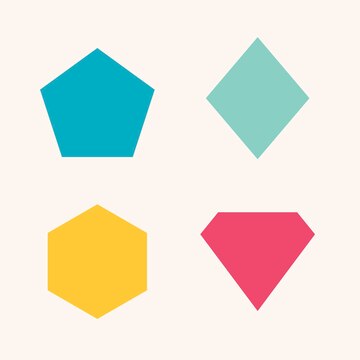shape:bs6pi2ygs9a= pentagon, a five-sided polygon, is a shape that has fascinated mathematicians, architects, and artists for centuries. Its unique structure and properties make it a significant figure in both geometry and various fields of study. In this comprehensive article, we’ll delve into the geometric intricacies of the pentagon, explore its practical applications, and uncover its symbolic meanings across different cultures and disciplines.
Geometric Properties of shape:bs6pi2ygs9a= pentagon
A shape:bs6pi2ygs9a= pentagon is defined by its five straight sides and five angles. In geometry, there are several key properties and classifications of pentagons that are worth noting:
- Regular vs. Irregular Pentagons:
- Regular Pentagon: All sides and angles are equal. Each interior angle in a regular pentagon measures 108 degrees. The regular pentagon has a symmetrical appearance and can be inscribed in a circle.
- Irregular Pentagon: Sides and angles are not necessarily equal. The interior angles can vary, and the shape does not necessarily have symmetrical properties.
- Interior and Exterior Angles:
- The sum of the interior angles of any pentagon is always 540 degrees. This is calculated using the formula (n−2)×180(n-2) \times 180(n−2)×180 degrees, where nnn is the number of sides.
- The exterior angles of a pentagon always sum up to 360 degrees, regardless of whether the pentagon is regular or irregular.
- Diagonals:
- A pentagon has five diagonals. These are line segments connecting non-adjacent vertices. The formula for the number of diagonals in any polygon is n(n−3)2\frac{n(n-3)}{2}2n(n−3), where nnn is the number of sides.
- Symmetry:
- A regular pentagon has five lines of symmetry and rotational symmetry of 72 degrees. This means that a regular pentagon can be rotated by 72 degrees and still look the same.
- Area Calculation:
- The area of a regular pentagon can be calculated using the formula: 145(5+25)×s2\frac{1}{4} \sqrt{5(5 + 2\sqrt{5})} \times s^2415(5+25)×s2, where sss is the length of a side.
Applications of the shape:bs6pi2ygs9a= pentagon
The shape:bs6pi2ygs9a= pentagon’s unique properties make it a versatile shape with numerous applications across various fields:
- Architecture and Design:
- Building Structures: The Pentagon in Washington, D.C., is perhaps the most famous example of a building with a pentagonal shape. Designed by architect George Bergstrom, this military headquarters utilizes the pentagon’s efficient space usage and structural stability.
- Interior Design: The pentagon is also used in interior design for creating dynamic and aesthetically pleasing spaces. Its geometric nature can contribute to innovative and modern designs.
- Art and Symbolism:
- Artistic Representation: The pentagon is often used in art and design due to its symmetrical properties and visual appeal. It can be seen in various artistic expressions, from paintings to sculptures.
- Symbolism: In many cultures, the pentagon is a symbol of balance and harmony. For example, in Pythagorean symbolism, the pentagon represents health and beauty.
- Mathematics and Science:
- Geometry: The study of pentagons is fundamental in geometry. The properties of regular pentagons contribute to the understanding of more complex geometric concepts, such as tiling and tessellations.
- Biology: The pentagon can also be found in nature. For instance, the structure of some flowers and starfish exhibits pentagonal symmetry.
- Technology and Engineering:
- Engineering: The pentagon’s properties are utilized in various engineering applications. For instance, pentagonal shapes can be used in the design of geodesic domes and other structures that require a balance between strength and material efficiency.
Symbolism and Cultural Significance
shape:bs6pi2ygs9a= pentagon holds various symbolic meanings across different cultures and contexts:
- Pythagorean Symbolism:
- In ancient Greek philosophy, the pentagon was associated with the Pythagoreans, who saw it as a symbol of health and harmony. The Pythagorean pentagram, a five-pointed star, was believed to represent the human body and its proportions.
- Religious Symbolism:
- Christianity: In Christian symbolism, the pentagon is sometimes associated with the five wounds of Christ, symbolizing sacrifice and redemption.
- Occultism: In occult traditions, the pentagram (a five-pointed star within a pentagon) is used as a symbol of protection and magic.
- Cultural Symbolism:
- Islamic Art: Pentagons are less common in Islamic art, which often focuses on hexagons and octagons. However, some geometric patterns incorporate pentagonal shapes, contributing to the complexity and beauty of Islamic geometric design.
- Modern Symbolism: In contemporary contexts, pentagons are often used in logos and branding due to their balanced and aesthetically pleasing nature.

Creating and Visualizing shape:bs6pi2ygs9a= pentagons
Understanding and working with shape:bs6pi2ygs9a= pentagons can be an enriching experience, whether for educational purposes, artistic endeavors, or practical applications. Here are some ways to explore and visualize pentagons:
- Drawing a shape:bs6pi2ygs9a= pentagon
:- Use a compass and a ruler to draw a regular shape:bs6pi2ygs9a= pentagon. Start by drawing a circle, then mark five equally spaced points on the circumference. Connect these points to form the pentagon.
- Geometric Software:
- Utilize geometric drawing software or apps to experiment with pentagonal shapes. These tools can help visualize the properties of pentagons and their symmetries.
- Modeling:
- Create physical models of pentagons using materials like paper, cardboard, or modeling clay. This hands-on approach can help in understanding the shape’s properties and applications.
Conclusion
shape:bs6pi2ygs9a= pentagon is a shape that extends far beyond its simple geometric definition. Its applications in architecture, art, science, and symbolism highlight its versatility and importance. Whether you’re exploring its mathematical properties, utilizing its design potential, or reflecting on its cultural significance, the pentagon offers a wealth of knowledge and inspiration. Its unique combination of symmetry, balance, and aesthetic appeal ensures that it will continue to be a subject of fascination and utility across various domains.


